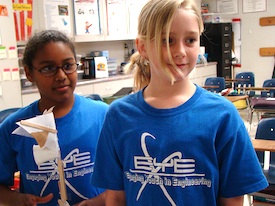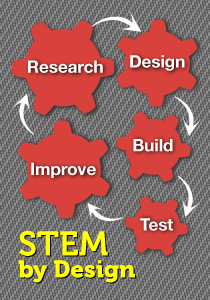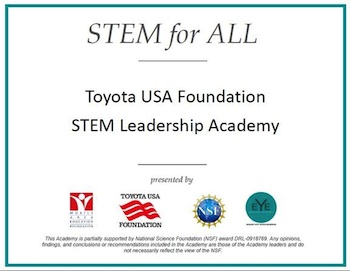Creating More STEM Leaders
A MiddleWeb Blog
Newsflash!
• Of the 20 fastest growing occupations projected for 2014, 15 of them require significant mathematics or science preparation to successfully compete for a job.
• Our nation has a shortage of qualified math/science/STEM teachers
• Our students’ math and science skills are simply inadequate.
Of course, none of that is really news. It’s more like a recipe for disaster. Businesses and industry have been asking for a better prepared workforce for years, and volatile 21st Century workforce demands compel us to hone in on knowledge and skills our students really need.
One particularly good question to think about: How can we ask teachers to prepare lessons in subjects in which they lack background knowledge? It’s an important question, of course, but it is often where many STEM initiatives start and stop. They focus on the short-term professional development needs.
That’s just the tip of the iceberg according to my friends on Mobile, Alabama’s Engaging Youth through Engineering (EYE) staff. Preparing teachers is but one part of a much bigger STEM solution, and we must work this problem from every angle. A complex curriculum innovation that seeks to integrate engineering design strategies into science, mathematics and technology requires community wide support, and that means leadership development that scales from the classroom to the executive suite.
A STEM leadership academy

In Mobile, STEM is viewed as part of a K-12 workforce and economic development strategy, and implementing STEM requires support and leadership at all levels. With a grant from the Toyota USA Foundation, Pruet has established the EYE on STEM Leadership Academy. In the summer of 2012 this unique Academy began preparing both the business and education communities to provide ongoing STEM leadership and support.
The Leadership Academy works with four tiers of STEM leaders, and each group is critically important.
1 • Business and Industry
A STEM initiative needs a core of respected business leaders who understand the feasibility of STEM education and can talk the talk. Empowering the business community to do this is one component of the Leadership Academy. Business leaders are generally agreeable – even enthusiastic – about supporting STEM, but they must be knowledgeable advocates.
These leaders know that students need to be able to apply the math and science they are learning to solve real-world problems. They know that these future employees need experience in being innovative problem solvers, team players, and communicators. But do they know that most districts have not allotted time for this in the curriculum? Basic STEM skills are difficult to teach to an employee after graduation. Who better that employers to affirm that this learning needs to take place throughout the education process? Business leaders are also the link to getting volunteers to help students during classroom STEM projects.
2 • District and School Administrators
A well-developed STEM program has a transformative effect on the entire education process in a school and a district. Accordingly, a variety of district-level leaders, including school principals, are involved in the EYE on STEM Leadership Academy. In addition to the usual players, such as the Division of Curriculum and Instruction, leaders from other divisions – instructional technology, career tech, and special education for example – are drawn into the circle.
Certain things must continue on after the initial groundwork is done to ensure that the STEM initiative goes beyond project status and becomes an established way of doing business. A district can develop leaders, but these STEM leaders must have an established and ongoing way of supporting STEM. If a district has STEM specialists, how is the district going to use them? District and school leaders in the Academy work together around a common vision to make these decisions.
3 • STEM Specialists
These are out-of-classroom experts who work with teachers. They are being trained as STEM specialists through the Leadership Academy — learning the What, Why and How of STEM so they can do a better job of integrating STEM into their work as they develop educational programs for teachers, students and the community. This group includes organizations such as the Alabama Math, Science, and Technology Initiative (AMSTI), the Dauphin Island Sea Lab, the GulfQuest Maritime Museum, the Environmental Studies Center, the Gulf Coast Exploreum, as well as retired educators, college staff and others. These emerging STEM specialists are part of a broad, informal educator population who will help provide an all-important ongoing STEM support network for K12 teachers.
4 • Classroom Teacher Leaders

As an FYI, the Academy has ambitious goals for these STEM teacher leaders. The teacher curriculum involves three strands: Applied STEM Content, integrated-STEM (i-STEM) Practices, and (the all-important) Leadership Skills. The two-year program for teachers consists of specially designed institutes, workshops, reflection seminars and practicum experiences. Participation will not only help these teachers understand how to use engineering design challenges as an instructional strategy, it will deepen their own content knowledge and develop the leadership skills needed to support other teachers as they implement STEM reform.
The ultimate goal
The ultimate goal of the EYE on STEM Leadership Academy is to have STEM-savvy community leaders and a staff of knowledgable and fully supported math and science teachers in each school, with STEM experts in place at each grade level.
Stepping back from Mobile and thinking more broadly about the nation’s STEM education needs, Dr. Pruet argues that wherever people are trying to implement STEM curriculum, they must figure out what it is the education system needs to accomplish, how STEM will help them do that, and what STEM will look like for their community. Communities must have a common vision and leaders who are on the same page.
The goal for Mobile and every community, she believes, is “to develop a community with a common vision of STEM so we can all join our collective talents, energies, and work to reach a goal of STEM success for all students.”


































Mobile Public Schools are fortunate to have a strong partner like the Mobile Area Education Foundation, and I do hope the STEM for All Leadership Academy becomes a working model for other districts across the country. This is what true education reform looks like and by bringing all players to the table, a pardigm shift is in the making!
I agree, Caroline. This Academy wows me. It’s such a thorough approach, and brings all the stakeholders to the table time and time again.
It seems to me there has to be an agreed on definition / vision of what a STEM school, STEM classroom, STEM lesson or project REALLY means (it could be somewhat broad I think). I serve one K-6 school that says it is a “STEM Academy” because teachers are told they are to teach science at least 15 minutes per day. Teachers there receive almost no PD in anything but literacy and math. Now this same large school district is going to change about 10 of its 85 K-12 schools into “STEM Academies,” – any help in what that should look like … or will STEM just become a worthless label to make it appear that changes are happening? Is there, or should there be a bottom-line / minimum of what happens at a school referred to as a STEM school? Is there any authority on what STEM education REALLY is? Other schools seem to think that “doing projects” every once in a while is STEM. Any thoughts? Thanks.
Brian—Your question is one many folks are asking these days about STEM. Just what is it and how do you recognize good STEM curriculum if we aren’t sure what STEM is? And, isn’t there a definition or maybe even some standards for these STEM Schools that are popping up all over. I don’t have definitive answers for you, but can share some of our insights from the EYE initiative here in Mobile, AL and connect you with some folks who helped develop standards for schools to become STEM Schools in NC. First,one of the NC contacts is Liz Parry. I’ll have to get you her email address. You might google her or the STEM Director for the NC Department of Education- Rebecca Pain. NC has just completed these standards and I think they will be a good place to start.
As to a definition of STEM itself — as best i can tell that varies widely. In some places STEM is more S. T. E. M. —meaning separate silos of good science, good math, etc. Some places it means the use of a lot of instructional technology in the school or class. Frequently the T and E are missing. In Mobile a common understnading of STEM has evolved in large part through our EYE work: STEM is an integrated approach to learning that uses engineering design challenges and the way engineers solve problems and create new technologies to solve these problems by integrating math and science. This is proving to be a very engaging way to bring rigor and relevance to required math and science content for all students in the middle grades and motivate students to take more math and science courses.
But six years ago we did not have this definition — it has evolved in our community largely in response to our area’s workforce needs. Perhaps you will be able to get the STEM conversation going in your community, as STEM needs to be what your community needs and wants. Best wishes in your STEM efforts!
Great comment, Brian. I think the answer is, Yes, there should be an agreed on definition of what STEM is. But, within obvious parameters, there should be some flexibility as to what the STEM outcome is. For exampIe, at the middle school level in Mobile, STEM is used to give purpose and application to math and science as kids use it to solve real-world problems. It’s actually math and science driven because specific standards have to be met through STEM. In another system, STEM focuses on the engineering problem and pulls in whatever math and science and technology is needed for the solution. Those are slightly different focuses. In the end, though, STEM does has to have the four components – science, technology, engineering, and math; and it must focus on integrating those subjects to solve a real-world problem.
I worry about the kind of STEM Academies you describe because the STEM initiative will loose its integrity if we deviate too much from the original model. Just because something has math doesn’t make it a STEM program. Language arts is fine, but STEM can’t leave science, technology, and engineering out of the picture. In the end, engineering is the linchpin that connects the others.
And no, not all projects are STEM projects. All science labwork and experiments are not STEM related.
Maybe the best help you can give the system that is forming the STEM Academies a picture of what EYE has done. A lot of groundwork and support has to be in place before STEM can be successful, and that includes a clear vision of what STEM is – arrived at by a broad coalition of impacted entities such as business and industry in collaboration with the education system.
Thanks for your thoughtful questions and your interest in this!
Thanks Anne and Susan. Your answers reinforce my experience. Not having an authority makes our jobs harder since that makes anyone an authority. I love my own state’s definition of STEM (and others’ as well):
The Nevada Department of Education defines STEM:
STEM (science, technology, engineering and mathematics) education focuses on active teaching and learning, centered on relevant experiences, problem-solving, and critical thinking processes. STEM education emphasizes the natural interconnectedness of science, technology, engineering and mathematics and their connection to other disciplines, to produce informed citizens that posses and apply the necessary understandings to expand Nevada’s STEM-capable workforce in order to compete in a global society.
But even a thoughtful definition is open to interpretation unfortunately. Let’s just keep plugging away and finding the great examples that exhibit quality STEM.
Thanks again!